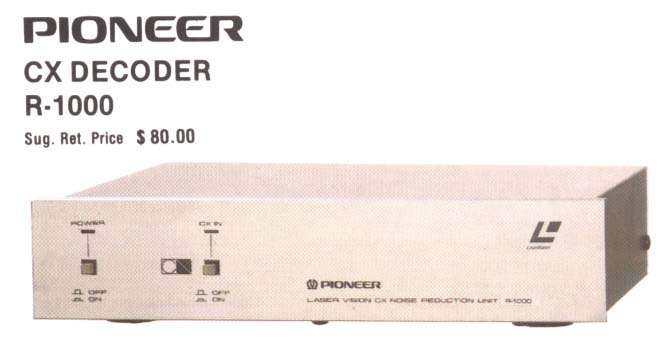|


The CX (CX stood for Compatible eXpansion) Noise Reduction System was added to the LaserVision format in 1982. Due to the
way LD's are encoded, the right channel FM audio carrier is too close to the video carrier. With high level/high frequency
audio or very bright scenes, these signals may overlap and interfere with each other causing audio distortion and on-screen
'beats'. In addition, the FM recording system used for the audio was suceptable to noise picked up from less-than-perfect
pressing techniques. Pioneer looked for a way to reduce the interference and noise without having to change the system specifications.
Both Dolby C type noise reduction and DBX Type II were submitted, but compatibility concerns (not to mention royalty rates)
lead Pioneer to adopt CBS Lab's CX (Compatible Expansion) Noise Reduction System. Originally developed for LP's, the CX system
was a 2:1 compressor/expander that worked somewhat like the Dolby and DBX systems but was designed for relatively quiet media.
Another design goal for CX was that encoded recordings wouldn't sound noticably 'compressed' when played back without decoding.
For LP's, CX provided 20db of noise reduction, but Pioneer changed the system slightly for better sound quality when UN-decoded,
thus reducing the noise reduction to 14db. Unfortunately, Pioneer completely botched the CX system. Titles would be listed
in catalogs as CX, but were not, titles without a CX mark WERE CX, and many titles didn't receive encoding at all. LaserVision
fans begged studio's and Pioneer to CX every disc, but Pioneer refused. All Pioneer had to do was flip a switch during mastering,
but they didn't. They wouldn't even tell studio's that CX was available. The studio had to specifically request it. This sad
state of affairs would be repeated when digital sound was introduced.
CX Noise Reduction allowed tube-based players
to achieve an audio signal-to-noise ratio of up to 72db (assuming a perfect pressing) with a dynamic range of 80db. Later
solid-state players achieved a S/N of over 80db.
As a side-note, it's really too bad that Pioneer didn't adopt the
dbx-II system as this would have provided up to 40db of noise-reduction and allowed a substantial increase in high-frequency
headroom. Pioneer's compatibility concerns were not really valid since there wern't that many early players in use - and with
low-cost dbx decoder's available, any owner of an early LV player could upgrade to dbx for less than $60 since standard tape/LP
dbx decoders would be 100% compatible with LV's use of the system.
Shown above is the only out-board CX decoder
produced for LaserVision discs. Since CX had to be precisely calibrated for each players audio output, the decoder had a switch
on the back to adjust it to work with the various players available, such as the VP-1000, the industrial 7820 and the Magnavox
8000 series players. The decoder wasn't widely available, many dealers not even stocking it; in fact, we never even saw it
in stores.
|

